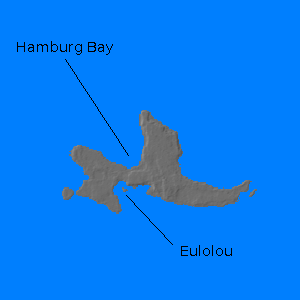![]() The Pacific War Online Encyclopedia
The Pacific War Online Encyclopedia
|
| Previous: Emerald Class, British Light Cruisers | Table of Contents | Next: Emmons, Delos C. |
 |
U.S. Marine Corps. Via Wikipedia |
Emirau (149.97E
1.65S) is located about 90 miles northwest of Kavieng in the St.
Matthias group. The island is irregularly shaped but about 8 miles (13
km) long and between 2 and 4.5 miles (3 and 7 km) wide. Most of the
island is a plateau ending in cliffs dropping 75' to 185' (23 to 56
meters) to the coastal plain, which is a few hundred meters wide and
consists of mangrove swamps along
much of the southern coast. Most of the coast was fringed with reefs, but there were decent anchorages at Hamburg Bay and
Eulolou. The island was covered with a mixture of light vegetation and jungle.
The island was completely undeveloped prior to the
war,
with a single track along its length with a spur into the northern
peninsula and a maze of trails in its western portion, and the Japanese presence was limited to a few coast watchers who were
withdrawn by January 1944.
On 12 March 1944 the Joint Chiefs of Staff, on
advice from Nimitz,
canceled the invasion
of Kavieng.
Nimitz believed that the AIRSOLS campaign
against Rabaul had made such a move
unnecessary. However, the amphibious force for the invasion had already been assembled by Halsey
at
Guadalcanal, and two days later
he ordered Wilkinson
to take Emirau instead. Griffin
took his old battleships, New
Mexico, Mississippi,
Tennessee, and Idaho,
to bombard Kavieng on 20 March, which proved an effective diversion.
Simultaneously 4 Marine
Regiment occupied Emirau without opposition, landing 3,727 men
across beaches on the southeast end of the island. At the same time,
the nearby Japanese seaplane
base on Eloaue Islet, off the south shore of of Mussau Island to the
northwest, was shelled by destroyers
and put out of action.
Within a month 18,000
men and 44,000 tons of supplies
had come ashore and a PT
base had been
established, and in early May the first airstrip was completed. Eventually
the island had two 7000' (2130 meter) runways on the northern peninsula.
References
The Pacific War Online Encyclopedia © 2008, 2010 by Kent G. Budge. Index